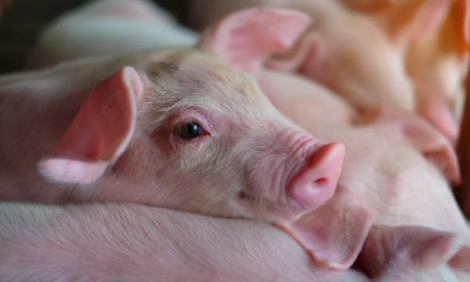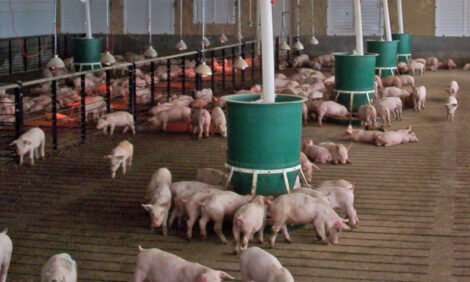



Controlling sow death losses
By Bernard Peet, Pig Production Training and thePigSite Consultant - Over the last 15 years, sow death loss has just about doubled in most countries, including Canada, the USA. Denmark and Britain. The latest available PigChamp data (Table 1) shows that, in a sample of Canadian herds, average annual mortality averaged 7.2%, with the worst 10% of herds averaging 10.8%.
Figures for US herds show similar but higher figures. A study by John Mabry at Iowa State University involving 42 herds reported that sow mortality increased from about 3.7% in 1992 to 7.3% in 2001, although it fell slightly to 6.5% in 2002 (Fig 1). It is now not uncommon in US sow herds to have mortality rates of 10% or more. Such a high death rate is not only of concern from a welfare viewpoint but is a source of major economic loss. Not only that, but the reasons that have led to such death losses have also increased sow wastage through higher culling rates. This, in turn, results in poorer productivity and higher costs of production.
| Sow death rates for 2004 | |||
| Canada | USA | ||
| Average | 7.2 | 7.9 | |
| Top 10% | 3.4 | 3.7 | |
| Lowest 10% | 10.8 | 12.0 | |
| Source: PigChamp Benchmarking Database | |||
There are, I believe, four main factors associated with this trend:
The decrease in gilt and sow backfat levels as a result of selective breeding for leaner, fast growing and efficient pigs
The intensification of production systems leading to harsher conditions which are more likely to lead to injury and a lack of suitable facilities to deal with sick, injured or disadvantaged gilts and sows
A lower level of "stockmanship skills" in the pork industry
More sows being euthanized on the farm due to increasingly strict legislation and enforcement of rules on transport of unfit animals.
Leaner sows more vulnerable
Backfat levels in gilts and sows are now extremely low, making them vulnerable to injury, particularly shoulder abrasions. Recent work by Denmark's National Committee for Pig Production showed that where sows have less than 15mm of backfat, they have very little protective fatty tissue over the shoulder blade, creating a high risk of shoulder abrasions and abcesses. The report noted that a sow with 15 mm of backfat may look in acceptable condition to the herdsman and not be considered thin. The Danish study measured the backfat level at farrowing of 500 sows in 5 herds. This showed that 25% of sows had a backfat thickness below 15mm (see Fig. 2). However, the same study showed that, as backfat at farrowing increased, backfat loss during the lactation period also increased. In other words, fatter sows at farrowing ate less in lactation and lost more backfat. A sow with 25mm of backfat at farrowing typically lost 5mm from farrowing to weaning whereas a sow with 15mm only lost about 2mm, due to differences in feed intake.
So, how do we overcome this problem in the commercial herd? First, breeding gilts heavier and older (and therefore fatter) has been shown to increase not only litter size but also longevity. Danish recommendations are for gilts to be 240 days and 150kg at first breeding. Bigger gilts are much more resilient to inadequacies in feeding or their environment. One strategy for gilts that has been widely used is to try to make the gilt lay down backfat prior to breeding by feeding a low lysine diet. However, this has been shown by recent British research work to be counterproductive as it leads to a reduction in first litter size.
The second important area of management is feeding during both gestation and lactation. Very high feed intakes in the suckling period are essential to avoid depletion of backfat. Factors that are involved in maximizing feed intakes are pre-farrowing feeding, room temperature, ration density and palatability, feed scale, water supply and frequency of feeding. Gestation feeding must ensure that sows enter the farrowing room with adequate backfat, something that is only possible if it is measured. Application of accurate feeding scales based on body condition will, on many farms, be an improvement, but in the longer term we may have to consider routine measurement of backfat on commercial units.
Harsh conditions increase injury
There is no doubt that higher death losses have been associated with the increase in slatted, un-bedded housing. Even in many new barns I see, the quality of concrete slats and solid concrete surfaces is rather poor. In some older barns, it's abysmal. This results in unacceptable levels of injury, infections, abscesses and joint problems, leading to premature culling or death. Better quality construction and materials would overcome a lot of problems. I could write a book about all the chipped slats, rough concrete, badly designed slats and equipment, uneven slatted panels and sharp edges I have seen. Attention to these areas during construction and regular repairs in existing barns is essential to minimize injuries.
Bearing in mind the level of the mortality and injury problem, very few barns have adequate, dedicated hospital pens. Such pens are mandatory in Europe and should be included in new barn designs or installed in existing barns. Ideally such pens should have bedding and solid floors because most sows and gilts going into them will have leg problems, shoulder sores or other physical injuries. Hospital pens not only allow recovery from health problems but also allow the herdsman to focus on individual animal care in a specialized facility.
Stock skills essential
The ability of the stockperson to identify a sow or gilt that is sick, injured or disadvantaged and then to treat it appropriately is central to controlling sow mortality. In the North American industry, as well as others, units have got bigger and at the same time the general level of ability of people working in both large and small barns has declined. I am extremely concerned about the impact of this on pig welfare because I've seen so many situations where stock workers fail to identify sick or injured pigs early enough or don't know how to deal with the situation effectively. High turnover of staff, low availability of suitable people and poor training make this situation worse. Many industries and individual producers around the world need to devote much more resources to ensure that staff are properly trained and fully understand animal behaviour.
Transport rules are stricter
Sow mortality in many European countries has increased dramatically due to extremely strict and well-enforced legislation on transport of sick or injured animals. This reason, although less important, is also a factor in North America. There is no doubt that such regulations will become increasingly strict, leading to increased euthanasia on the farm.
High sow death losses cost the Canadian industry many millions of dollars. Attention to some of the areas outlined above will help to keep deaths at an acceptable level of 5% or less.

Source: Mabry, Iowa State University
Figure 2:

Source: National Committee for Pig Production - Denmark, Annual Report 2004
|









